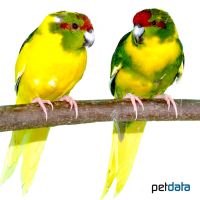Spotted Red-fronted Parakeet (Cyanoramphus novaezelandiae 'Spotted')
| Spotted Red-fronted Parakeet Cyanoramphus novaezelandiae 'Spotted' | |
|---|---|
| Name | Spotted Red-fronted Parakeet |
| Name Lat. | Cyanoramphus novaezelandiae 'Spotted' |
| Family | Parrots |
| Family lat. | Psittacidae |
| Order | Parrots |
| Order lat. | Psittaciformes |
| Origin | New Zealand |
| Climate | Temperate - tropical |
| Diet | Large Parakeet seed, veggies, fruits |
| Keeping | Pair, group |
| Care Level | Easy |
| Reproduction | Cavity nest |
| Life Span | 10-15 years |
| Protection | CITES Appendix I; EC Annex A |
| Metric Units | |
| Size | 27 cm |
| Temperature | Room temperature |
| Housing | 200 x 100 x 100 cm |
| US Units | |
| Size | 10.6" |
| Temperature | Room temperature |
| Housing | 80" x 40" x 40" |
Distribution and habitat
The goat parakeets are widespread in New Zealand, the surrounding islands and New Caledonia. They live in different biotopes, (forest areas, open grassland). Since the export ban in 1960, they are only available as a breeding form. The pied goat parakeet is a color mutation.
Cage size
The minimum cage size is 200 x 100 x 100 cm (L x W x H) for a pair. The cage size must not be undercut even in case of justified single keeping. For an additional 2 birds, assuming species compatibility, the floor space must be increased by 50%. The cage must be placed at a height of at least 80 cm (except aviaries) in a bright, draught-free and quiet place and should have cross-wiring or netting. Keeping in an aviary with a floor area of at least 3 m² is preferable to keeping in a cage.
Maintenance
The floor must be covered with sand, shavings of untreated wood or similar material and must be cleaned regularly. At least 2 perches made of wood or branches of different thickness and height shall be installed in such a way as to provide the longest possible flight path and prevent contamination of the feed and water containers. A bathing facility should be available at all times, alternatively they can be sprayed with water at least once a week. They need climbing and occupational material, such as rings, ropes and natural branches and twigs that are not harmful to their health. They should be kept at room temperature.
Diet
The species-specific food offer consists of mixed seeds, available in specialized trade as "large parakeet food" in premium quality, supplemented with cob millet, green food (dandelion, chickweed, green panicle millet), vegetables (peppers, carrots, etc.), fruit (apples, pears, etc.), berries, fresh twigs, occasionally insect food and, especially for raising young, sprouted seeds (wheat or corn), meal beetle larvae and egg food. They need grit, cuttlefish and vitamin lime as digestive aids. Water must always be available in birdbaths or in stable, open containers. Feed and water must be offered fresh daily, and the containers must be cleaned beforehand.
A varied diet promotes health and prevents deficiency symptoms.
Reproduction and breeding
The females have a narrower red headband.
They breed in nest cavities made of soft wood or in hollowed tree trunks. Sawdust from coniferous wood, mulch and small twigs are particularly suitable as bedding. The clutch consists of 4-9 eggs and the incubation period is about 20 days. The incubation period is, biologically speaking, from March to August when kept in an open aviary. Young birds should be raised so that they are species-specific.
Species protection
They must be identified under species protection law in accordance with Annex 6 to the Federal Species Protection Ordinance. They are exempt from the obligation to notify (Federal Species Protection Ordinance Annex 5 to § 7 para. 2). Your pet store will be happy to provide you with further information.
Species protection: WA Appendix I; EU Appendix A. You will receive a CITES document with the purchase, which confirms that this animal is an offspring. Please keep the CITES document in a safe place!
Important
In the case of outdoor aviaries, they also need a heated shelter of at least 1 m², which can be visited by the birds at any time. The temperature in the shelter must not fall below 10 °C and the furnishings must correspond to those of cage housing
The goat parakeets have their name because of their bleating sounding voice. They often stay on the ground and scratch for food. They do not use their beaks for climbing.
They may only be kept in pairs or in a group. In rooms, including shelters, adequate daylight or flicker-free artificial light (stroboscopic effect) corresponding to daylight should be provided. The lighting duration shall be 8-12 hours per day and the natural day-night rhythm shall be observed. Adequate indoor climate should be provided. If caged, they should be allowed free flight. The health condition of the birds should be checked daily. Further literature can be found in your pet store.
References
Text: petdata; Image: petdata
Source: BMELV (1995): Tierschutzgutachten - Mindestanforderungen an die Haltung von Papageien; ARNDT (1997): Lexikon der Papageien, Arndt Verlag; GRUMMT & STREHLOW (2009): Zootierhaltung - Tiere in menschlicher Obhut: Vögel, Verlag Harri Deutsch
- Gemäß § 21 Abs. 5 Tierschutzgesetz idgF
